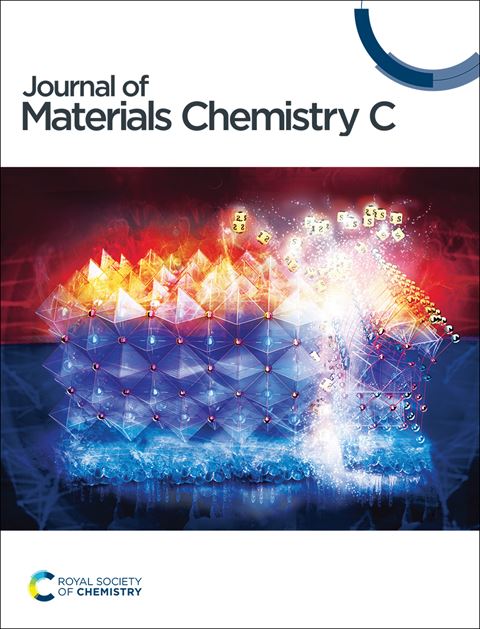从单染料掺杂的同手性聚乳酸微球†中诱导蓝、绿、红三色圆偏振发光
IF 5.1
2区 材料科学
Q2 MATERIALS SCIENCE, MULTIDISCIPLINARY
引用次数: 0
摘要
通过将非手性荧光染料掺杂到手性聚合物基体中,可以诱导圆极化发光。本研究展示了手性聚l -乳酸(PLLA)与荧光染料9,10-双(苯乙基)蒽(BPEA)的超分子自组装,形成微球生成cpld。随着BPEA浓度的增加,荧光颜色从蓝色变为绿色和红色,表明形成了BPEA二聚体和j聚集体。当BPEA/PLLA比为0.1时,微球悬浮液的发光不对称系数(glum)最高,为3.1 × 10−2。本文章由计算机程序翻译,如有差异,请以英文原文为准。

Induced blue, green, and red-colour circularly polarized luminescence from single dye-doped homochiral poly(lactic acid) microspheres†
Circularly polarized luminescence (CPL) can be induced by doping an achiral fluorescent dye into a chiral polymer matrix. Here, we demonstrate the supramolecular self-assembly of chiral poly(L-lactic acid) (PLLA) with the fluorescent dye, 9,10-bis(phenylethynyl)anthracene (BPEA), forming microspheres that generate CPL. As the BPEA concentration increases, the fluorescent colour shifts from blue to green and red, suggesting the formation of BPEA dimers and J-aggregates. The highest luminescent dissymmetry factor (glum) of 3.1 × 10−2 was obtained from the microsphere suspension at the BPEA/PLLA ratio of 0.1.
求助全文
通过发布文献求助,成功后即可免费获取论文全文。
去求助
来源期刊

Journal of Materials Chemistry C
MATERIALS SCIENCE, MULTIDISCIPLINARY-PHYSICS, APPLIED
CiteScore
10.80
自引率
6.20%
发文量
1468
期刊介绍:
The Journal of Materials Chemistry is divided into three distinct sections, A, B, and C, each catering to specific applications of the materials under study:
Journal of Materials Chemistry A focuses primarily on materials intended for applications in energy and sustainability.
Journal of Materials Chemistry B specializes in materials designed for applications in biology and medicine.
Journal of Materials Chemistry C is dedicated to materials suitable for applications in optical, magnetic, and electronic devices.
Example topic areas within the scope of Journal of Materials Chemistry C are listed below. This list is neither exhaustive nor exclusive.
Bioelectronics
Conductors
Detectors
Dielectrics
Displays
Ferroelectrics
Lasers
LEDs
Lighting
Liquid crystals
Memory
Metamaterials
Multiferroics
Photonics
Photovoltaics
Semiconductors
Sensors
Single molecule conductors
Spintronics
Superconductors
Thermoelectrics
Topological insulators
Transistors
 求助内容:
求助内容: 应助结果提醒方式:
应助结果提醒方式:


